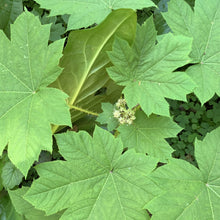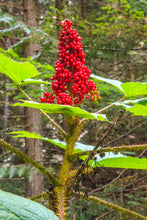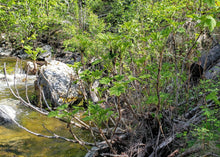
Oplopanax horridus
Every Pacific Northwesterner can recall special hikes where they’ve happened upon this primordial shrub growing formidably along a woodland stream. Well-deserving of both its common and scientific names, devil's club is sure to be an captivating addition to a shady and moist corner of your habitat garden. Oplopanax is derived from "hoplon", meaning weapon and "panakos" meaning panacea and referring to its revered medicinal and ceremonial qualities.
Its immense maple-like leaves unfurl on hardy, sprawling branches that are blanketed in threatening, but brittle, yellow spines. Greenish-white flowers form in dense clusters on large conical racemes, eventually maturing into showy scarlet berries by summer, which persist into winter. Devil's club tends to be slow growing, taking many years to reach seed-bearing maturity, making it quite sensitive to human impact and uncommon in the nursery industry. Now’s your chance to get this striking, uncommon plant established in your habitat haven!
- Plant type/canopy layer: deciduous, perennial, large shrub
- Size at maturity: 2-12' tall; 3-6' wide
- Light requirements: partial to full shade
- Moisture requirements: moist to wet soil, prefers well-drained
- Bloom time: May - August (May - July in the Portland Metro area)
- Growth rate/ease: medium growth rate, easy to grow
- Wildlife support: flowers attract and support bees and other insect pollinators; young stems and foliage are browsed by bear, deer and elk; the overall plant provides excellent refuge for various birds and small mammals, as well as shade and cover for salmon and their eggs, which in turn creates popular areas for bear that take advantage of both the fish and the berries
- Native habitat/range: grows in moist dense forest habitats, especially old growth conifer forests, and streamside, ditches, talus slopes and other wet areas, from sea level to 1800 meters, on both side of the Cascade crest from southern Alaska and the Yukon Territory to southwestern Oregon in the west; to Alberta, the Idaho panhandle and neighboring Montana in the east; with a disjunctive population on islands in Lake Superior (listed as threatened in Michigan). Portland Plant List - yes.
-
Special features & uses: landscape uses include pollinator gardens, raingardens, woodland gardens, erosion control, and native hedgerows; nearly all parts of this plant have been used ethnobotanically by indigenous people for thousands of years (always seek advice from a professional before using a plant medicinally. Sparrowhawk can not take any responsibility for any adverse effects from the use of plants);
- Medicinally - the bark and roots were chewed or boiled into an infusion or decoction to treat aches and pains (especially due to arthritis), sores and wounds, colds and flu, digestive disorders, lung ailments, cancer, as an eyewash for cataracts, as a laxative, and was considered useful before and after childbirth; a poultice of bark has been used as a boil and ulcer treatment, skin wash, and used to treat wounds, diabetes and as a pain reliever; the ash of the stem can also be used topically to decrease swelling
- Ceremonially the inner bark was chewed during purification or power-seeking rituals by hunters, warriors and shamans and the spiny stems were used as protective charms against supernatural evil powers and for good luck
- Other uses - the poisonous berries can be mashed into a foam and rubbed on the scalp to combat lice and dandruff and to make the hair shiny, the wood is useful for lures and hooks for fishing, bark shavings can be were mixed with different berries to make paint or basket dye; young, spring buds can be boiled and eaten as a famine food
Gardening with Devil’s Club: In the garden, this plant will require plenty of space to accommodate its sprawling, thickety form and irritating spines. It prefers moist to wet acidic soil and full to partial shade. As such, it makes an excellent barrier plant, or striking backdrop along a pond, stream or moist raingarden.
Photo Credit 1: © Ashwin Srinivasan, some rights reserved (CC-BY)
Photo Credit 2: (c) Kaden Slone – some rights reserved (CC BY)
Photo Credit 3: "Touch this plant at your peril!! (Devils Club - Oplopanax Horridus) (13657936263)" by Murray Foubister is licensed under CC BY-SA 2.0.
Photo Credit 4: (c) machaut2 – some rights reserved (CC BY)







